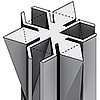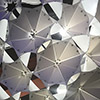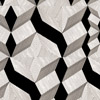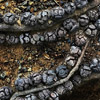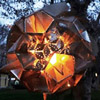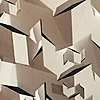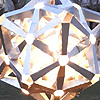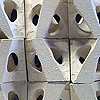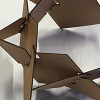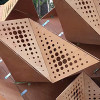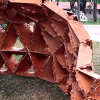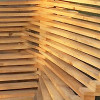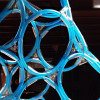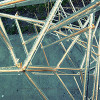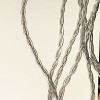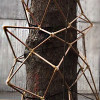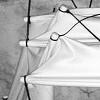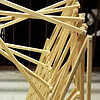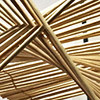This paper investigates the integration of robotic fabrication into first-year undergraduate design education, particularly in a basic design studio. Traditionally, robotic technologies are not introduced at this level due to perceived skill gaps among novice students. The study demonstrates the potential and strategies for incorporating robotic arms into early design education through an experiment conducted at Istanbul Bilgi University. The experiment involved 32 students from various design disciplines, divided into […]
Posts categorized under Basic Design
“Strange Start Startling Stop” was designed by Mary Purdy at the State University of New York in 1985. The composition is based on a hexagonal lattice (above figure). There are four prototiles, marking the four key moments in the shape-shifting process. The first prototile is a regular hexagon, which is also the first tile of the composition. This prototile morphs into a shape that is a composition of four smaller […]
This is a student project of the Computation-based Basic Design Lanterns finals of the year 2019. This year was exceptionally successful in creating 3d components and constructing relationships as a systematic whole. Again, the students started with small-scale experiments on folding and attaching cards. This is a study of how planar elements can generate volumetric units. They also studied Archimedean solids to understand geometric performances of particular shapes. We encouraged […]
One of the new assignments of our Computation-based Basic Design studio is called “Self-Organizing Patterns”. Although I’m not very sure about their self-organization potential, there are several good examples of systematic pattern-making. In the third week of their design education, some of the students proved themselves very well in analyzing and re-configuring natural structures in 2D abstract compositions. Selina Şişik Kardelen Kurt Sude Aydın
This is the first assignment named Design in the Forest of the new “Computation-based Basic Design” curriculum at İstanbul Bilgi University Faculty of Architecture. We are excited to see the students merging their conceptions of natural structures with the skills they start gaining in geometry classes. In the next assignments, we expect to generate patterns and structures by the abstraction of these initial sketches. Humay Aliyeva Sude Akay Here is an […]
In the first-year Computation Based Basic Design studio at İstanbul Bilgi University, the aim is to help students understand that design, due to its prevalent relational nature incorporates different forms of reasoning as indispensable constituents within the creative process (Yalınay Çinici, 2013). The studio integrates the 1:1 scale construction via computational thinking which consists of geometric relations, material computation/performance, and CAD/CAM technologies. The aim of the studio is to develop an awareness of immediate or far surroundings […]
The Cut & Fold & Craft exercise is the mid-term project for last year’s Computation-based Basic Design Studio at İstanbul Bilgi University Faculty of Architecture. I really enjoyed the technique called Kirigami. Most of the projects are not flat-foldable but they are all cut from a single sheet of paper. This technique seemed a little bit limiting at the beginning, but the students managed to design very interesting compositions in […]
This year’s Computation-based Basic Design Studio finals were very successful. Below are some of our student’s design works, and lanterns that light the campus area at İstanbul Bilgi University. It was a great experience for them to seek a design system between the domains of material computation and architectural geometry. 28 first-year students of architecture, interior design, and industrial design completed their projects in groups of 4. Students: Aleyna Demirkök, Aleyna Yıldız, […]
In the last semester’s mid-term project of Computation-based Basic Design 2, we experimented with the casting method for studying solids and voids. Students worked in groups of four. First, they designed a set of components within a 10cm bounding cube. These cubes represent 1m3 on a 1:10 scale. After that, they multiplied them into a system of voids with a function for human use. They fabricated at least 24 pieces […]
This project started as a study on a geometric method called quadror, but resulted in an amazing self-standing structure with the capability to fold flat. Initially, after Ayza made lots of sketches and models, the project team continued the research and finally, they managed to build one prototype only in two days. Here are some photos of this project but there are much more variations and models on their own […]
Another well-organized group of students produced this self-standing structure in only a couple of days. This group joined the same 8mm wooden plates into a set of components of 8-sided polyhedra. Then, they joined these components in a fashion that the macro form emerged from the angles of their geometry. Below are some of the pictures of their production phases: The final prototype Some phases of the production Model of […]
A very hard-working group from this year’s Computation-based Basic Design Studio produced this amazing structure. They joined 8mm cnc-cut wooden plates using puzzle-like cuts and tightened them with strings. A good example of group coordination produced this result in two days. Below are some photos of the prototype and the project phases: Final prototype. Interlocking Structure The joint details and the first experiments. *Students: Aslı Naz Çolakoğlu, Aybike Yılmaz, Bilge Kardelen […]
In this final project for İBU Basic Design Studio in 2015, wooden sticks are arranged to produce ruled surfaces for various uses such as sitting, leaning, etc. Here are some photos of the final prototype and its production phases. Final prototype Digital model First sketches. *Students: Dilara Çerçi, Elham Kaya, Gizem Kama, Gül Zorlu, Gülşah Kılıç, Orhan Ünver, Yiğit Altındağ, Sena Ortaç Here is the students’ blog on this project.
The Hose is our last material system of 2014, designed and produced at the Computation-based Basic Design I studio section. We instructed this section together with Can Sucuoğlu and Birgül Çolakoğlu. This group of students succeeded in developing a flexible but strong connection detail. It allowed them to generate the desired macro form quickly. However, the overall look of the final composition should have been much better. Because, it was placed in […]
The 2015 Basic Design Studio was one of the good seasons. The project named “Fireball” is an example of high concentration. A group of students developed a material system from a very weak connection detail. The interesting part of the project was making it possible to stand by itself. They created the result purely by experimentation. In the beginning, they decided on the components and the overall geometric composition. So their […]
This student project named Happy Ivy was lightweight but also very strong, a good start for research on fibrous structures. The 2015 group of first-year Basic Design students explains their project as; Arboriform, meaning “something tree-shaped” was the central theme of the project, however, we decided to focus more on the entwining movement of ivy. In order to create a material system that reflects this entwining behavior, we chose to research fibrous […]
This is a student project on Computation-based Basic Design at Bilgi. The group of students completed it in the 2015 Spring semester. This research was very successful in achieving its intended physical performance, which was holding on to a tree designed for (and even near climbing up in some cases). The system is lightweight yet very powerful, holding on but not causing any harm to its “host body“, the tree. […]
This is an unfinished research on textile tensegrity technique, developed at Basic Design I Studio of Istanbul Bilgi University. The result was not satisfactory as a design outcome, but yet an interesting educational experiment. Students explain their project as follows: Coral reefs and corals themselves were starting points of our research. After analyzing some of the coral forms and a couple of studio sessions, we came up with experiments of […]
This project named Two Plus One explains itself very well. The students explained their motivation differently from the rest of the studio. In our Computation-based Basic Design Final Project, we are inspired by Theo Jansen’s Strandbeest sculptures, and we wanted to make our arboriform kinetic. First, we made a copy model of the original kinetic sculpture for ourselves in order to observe its shape, parameters, and movement patterns. We realized that the […]
Student project of the first year Computation-based Basic Design I studio at İstanbul Bilgi University Faculty of Architecture. The contextual background is based on “Arboriform” which aimed to drive students’ design research process. Here is a quote from the student’s presentation: …Many of us do not believe and even do not want to believe in the compatibility of natural phenomena with things done by humans. Nature eliminates unfitted environmental factors while generating new potentialities […]


